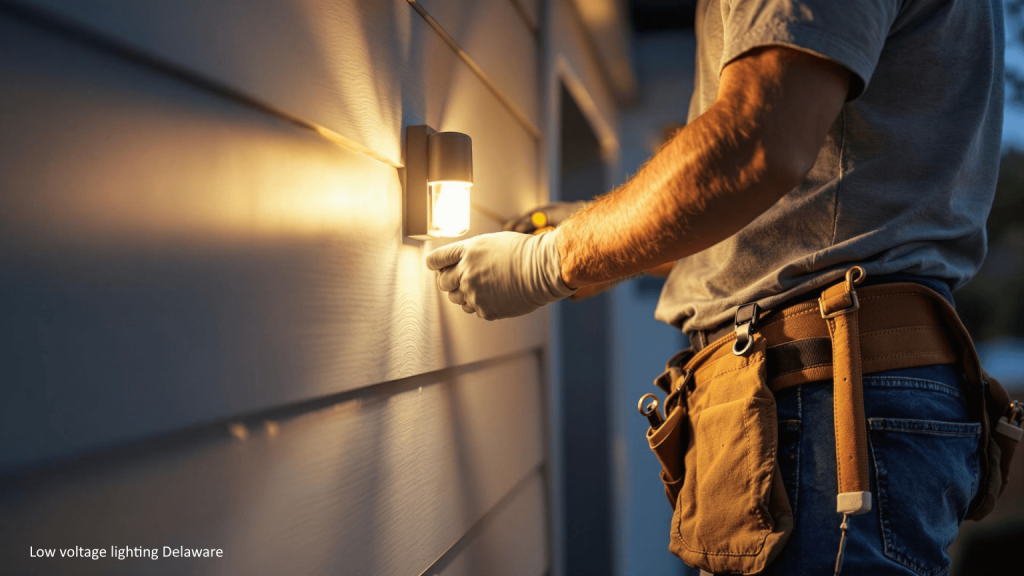Enhancing the beauty and functionality of outdoor areas can be achieved through the strategic use of low voltage lighting. This innovative approach not only elevates the aesthetic appeal of gardens and pathways but also ensures safety and energy efficiency. Here, we will explore the various facets of this solution, its numerous benefits, and how it can effectively transform your property.

What is Low Voltage Lighting?
These lighting systems operate on a reduced electrical voltage, typically around 12 volts.  This makes them a safer alternative to traditional high voltage setups, particularly in outdoor settings. They are ideal for illuminating gardens, walkways, patios, and other outdoor spaces without the risk of electrical shock. Additionally, their lower energy consumption contributes to reduced electricity bills, making them an environmentally friendly choice.
This makes them a safer alternative to traditional high voltage setups, particularly in outdoor settings. They are ideal for illuminating gardens, walkways, patios, and other outdoor spaces without the risk of electrical shock. Additionally, their lower energy consumption contributes to reduced electricity bills, making them an environmentally friendly choice.
Why go low voltage?🔌💡 Low-voltage landscape lighting is safe, energy-efficient, and perfect for creating a cozy ambience. Ready to transform your outdoor spaces? #Low#voltage#landscape#lighting#security#cameras#Sign#Lighting#Kitspic.twitter.com/knogzndJMp
Key Benefits
- Enhanced Safety: The reduced voltage minimizes the risk of electrical hazards, making it a safer option for outdoor installations.
- Energy Efficiency: These systems consume less power, leading to lower energy costs and a smaller carbon footprint.
- Design Versatility: Low voltage fixtures come in a variety of styles and designs, allowing homeowners to customize their outdoor aesthetics.
- Simplified Installation: Many low voltage lighting systems are designed for easy installation, often requiring no professional assistance.
Types of Low Voltage Fixtures
There are several types of options available, each serving different purposes and enhancing outdoor spaces in unique ways. Here’s a brief overview:
| Fixture Type | Description | Ideal Applications |
|---|---|---|
| Pathway Lights | Illuminate walkways and driveways, providing safety and guidance. | Pathways, gardens, and driveways. |
| Spotlights | Highlight specific features such as trees, sculptures, or architectural elements. | Focal points in gardens or yards. |
| Flood Lights | Provide broad illumination for larger areas. | Patios, decks, and outdoor gatherings. |
| String Lights | Add a decorative touch and ambiance to outdoor spaces. | Patios, pergolas, and events. |
Top Benefits of Low Voltage Outdoor Lighting
Installation can be a straightforward process, especially with the right preparation and tools. Here are some tips to ensure a successful installation:
- Plan Your Layout: Before installation, sketch a layout of your outdoor space and determine where you want to place the fixtures. Consider the areas you want to illuminate and the overall design.
- Use Quality Materials: Invest in high-quality fixtures and cables to ensure durability and longevity. Look for weather-resistant materials that can withstand outdoor conditions.
- Follow Manufacturer Instructions: Always adhere to the installation guidelines provided by the manufacturer to avoid any issues.
- Test the System: Before burying cables or securing fixtures, test the entire system to ensure everything is functioning correctly.
Pros and Cons
Like any lighting solution, low voltage systems come with their own set of advantages and disadvantages. Here’s a breakdown:
| Pros | Cons |
|---|---|
| Safer to install and use, reducing the risk of electrical shock. | May not provide as much brightness as high voltage systems. |
| Energy-efficient, leading to lower electricity bills. | Requires a transformer, which can add to initial costs. |
| Versatile design options to suit various outdoor aesthetics. | Limited range for wiring distance; may require additional cables for larger areas. |
| Easy to install for DIY enthusiasts. | Potential for lower durability if low-quality materials are used. |
Top Considerations When Choosing Low Voltage Lighting
When selecting the right low voltage lighting for your outdoor spaces, keep these key points in mind:
- Brightness Levels: Consider the lumen output of the fixtures. Higher lumens mean brighter light, which is essential for safety in pathways and driveways.
- Color Temperature: Choose the right color temperature (measured in Kelvin) to create the desired ambiance. Warmer tones (2700K-3000K) are often preferred for outdoor settings.
- Fixture Material: Opt for materials that are resistant to rust and corrosion, such as stainless steel or aluminum, to ensure longevity.
- Maintenance: Consider how easy it is to maintain the fixtures. Some designs may require more frequent cleaning or bulb replacements.
Final Thoughts
Illuminate your outdoor spaces with the magic of low voltage lighting—where safety meets style and energy efficiency. Dive into a world of diverse fixtures and installation tips to make savvy choices that elevate your home’s exterior. Whether you’re lighting up a garden path, spotlighting architectural gems, or setting the mood for cozy gatherings, transform your outdoors into a stunningly lit oasis.
Contact Conductive Electrical Contracting for a FREE Estimate:
Conductive Electrical Contracting
59 Elwood Drive
Smyrna, DE 19977
302-659-5000
This content has been peer reviewed and held to the highest editorial standards.


